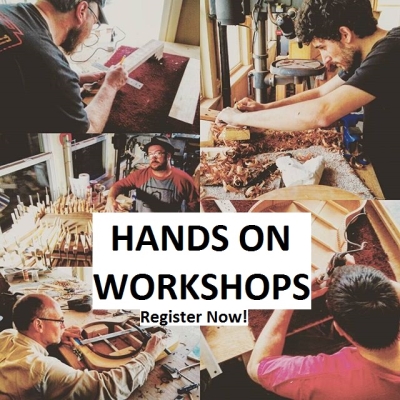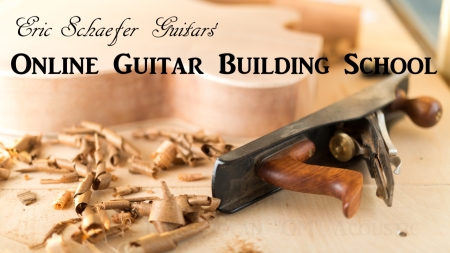In part I of “Acoustic Guitar Design: An Insight into the Choices Made by Luthiers” I discussed body dimensions, scale length, string spacing, fretboard radius, neck profiles, fretwire size, wood selection and bracing. It was a very superficial glimpse into a number of complex topics. So much so that it is worthy of this disclaimer:
*Disclaimer: This is in no way a comprehensive overview of the considerations that go into designing an acoustic guitar. Not even close! Each topic presented here deserves a book of its own. The thoughts expressed here are intended only to scratch the surface of understanding and hopefully provide a jumping off point for further exploration into that specific topic.
I’ve since decided to go a little deeper with the followup articles to “Acoustic Guitar Design: An Insight into the Choices Made by Luthiers” and present a single topic per article so that I can give each topic its due consideration. The above disclaimer, however, still applies!
Fretboard Woods
Ebony
The ideal fretboard material needs to be hard, stable, close grained and smooth to the touch. Dark colored woods are also very much preferred over light colored woods by consumers and builders alike. There are two reasons for this:
- Light colored woods can develop a dirty smudged appearance over time from the oils on the player’s hands.
- Tradition: A jet black fingerboard is simply what we expect to see on a stringed instrument.
This is why jet black African and Indian Ebony has long been the wood of choice for fretboards. The bad news is that the situation with Ebony in the global marketplace is not good. Bob Taylor of Taylor Guitars spoke very elegantly on the topic some years back:
The gray to light brown streaks commonly found in Ebony follow the annual growth rings of the tree. For this reason flat-sawn Ebony is more likely to be jet black than boards cut on the quarter, which show the streaks following the grain. This is a situation of compromise for some. While quarter sawn boards are ideal for stability, they are also more likely to have these aesthetic “imperfections.”
I, for one, think the streaking is beautiful and gives every instrument unique character. Furthermore, very light streaking darkens to jet black, or nearly so, over time.

Ebony fretboards on the left: Notice the prominent light streaking on the one board and the nearly jet black consistency of the second board. Rosewood (on the right) by comparison is much more varied in its color and composition, sometimes even approaching the look of jet black Ebony.
Rosewood
Rosewood is the most commonly used fretboard material found on guitars today.
There are many varieties of Rosewood (Cocobolo, Indian, Madagascar, Amazon, Palisander, Brazilian) and there are often striking aesthetic differences between the species. Even within a given species, there is often noticeable variety in color and composition from tree to tree. Again, this is a good thing. This is what makes working with wood exciting!

Fret position markers are easy to inlay on this rosewood fretboard. Any gaps from the inlay process can be made invisible with a little Ebony dust and superglue.
Tip: Some builders seeking the jet black Ebony look will “Ebonize” an already dark piece of Rosewood. This means that they use dyes to color the light banding in the grain pattern to match the darkest bands.
Maple
Maple is more commonly seen on electric guitars. Like Ebony, Maple is hard and stable enough to be used flatsawn or quartersawn. Unlike Ebony, Maple is very light in color. Maple with flamed or a “birdseye” figure is especially prized.
![IMG_20151105_144720[1]](http://www.ericschaeferguitars.com/wp-content/uploads/2015/11/IMG_20151105_1447201-768x1024.jpg)
The major downside of using Maple as a fretboard material is the need for a finish over the raw wood. This gives the fretboard a “slippery” feel, which is often undesirable, although some player’s prefer it.
Alternatives
Ebony, Rosewood and, to a much lesser degree, Maple have been the big 3 for fretboard wood, but all that is changing rapidly. Just some of many excellent alternatives:
- Katalox
- Bloodwood
- Persimmon (in the same genus as Ebony)
- Granadillo
- Macacauba
- Machiche
- Ovangkol
- Padauk
- Pau Ferro
- Wenge
- Ziricote
- Kempas
- Bubinga
- Goncalo Alves
- Canary
- Bocote
- Purpleheart
All of these woods possess, in varying degrees, the characteristics that made Ebony and Rosewood a fretboard material mainstay for decades: Hardness, stability, closed pores and a smooth feel. And they have been right under our noses all along!
The exciting part is working with alternative species with a variety of colors, even bright reds (Bloodwood) and purples (Purpleheart). They also possess a varied sound profile, workability, texture, consistentency, and grain structure. Many of these woods I have yet to personally experiment with, but have heard them recommended by others. Personally, I view the alternatives as opportunities rather than challenges.
In my opinion, the situation with Ebony and other dark woods presents more opportunities than limitations. It is an exciting time to be a guitar maker, or any woodworker for that matter, as fashions rapidly change and our eyes are opened to just how set in our ways we’ve become with “traditional” wood choices, and how much variety there truly is out there!
If the situation suddenly reversed tomorrow and Ebony became cheap, abundant and sustainable, I would hope that the fashion of seeking alternatives, not for ethical reasons but for the sake of originality and art, would continue unabated.
Was this useful? I would love to hear your questions or comments! I try to answer every e-mail I receive, so please be patient with me ![]() eric@ericschaeferguitars.com
eric@ericschaeferguitars.com
Want more of this? Subscribe below for Weekly Guitar Making Tips on “The Small Shop Luthier Blog”
Want to learn more? Take a class with Eric Schaefer and build your own guitar in 8 days


